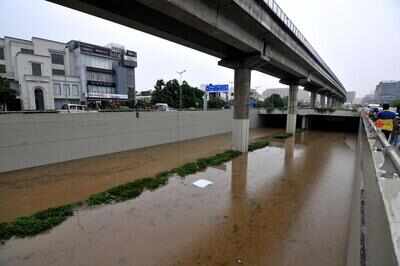
GURUGRAM: Wednesday’s heavy downpour bared everything that is wrong with the city’s drainage network.
Not just drainage, but faulty planning of buildings and topographical factors are being seen as the primary reasons why it took just a few hours of rain to leave almost all of Gurugram flooded.
Civic experts have underlined that the government should not only revamp the city’s drainage network to create an outlet for water accumulated from rain, they should also build dams to check the flow of water from the Aravalis.
Surrounded by the Aravalis on all sides but one, the topography of Gurugram is undulating. So, while Gwal Pahari (east) along the Delhi border is situated at a height of 290 metres, Najafgarh (west) at the lowest point at 200 metres. This difference of 90 metres leads to water from the Aravalis gushing down to the city’s low-lying areas. To put into perspective, the difference between the two points of Gurugram is around 20 metres more than the height of Qutub Minar.
To check this flow of water, the authorities urgently need to repair some 100-odd small dams that had been built during the British regime. Over the years, these dams have run into neglect. Another topographical factory that needs mention is the rapid urbanisation of the city at the cost of water bodies, which are crucial to holding the flow of water during rains.
Over the years, the authorities have looked the other way as builders have filled waterbodies to create highrises. And as condominiums replaced lakes and ponds, the developers unwittingly built roads that fall on the very path of the water flow. “As societies have come up on waterbodies, a part of the Aravali ecosystem has been destroyed. The city has been built to cater to the needs of a few private developers, who haven’t given any thought to the topographic characteristics of the region,” said Mukta Naik, a fellow at the Centre for Policy Research.
VS Kundu, the CEO of GMDA, said the civic authorities had taken measures, but they needed to do more. “Accidentally or otherwise, many water channels have been destroyed because of development. That’s what is happening on Sohna Road with the construction of the highway. We had tried connecting it with a drain temporarily, but it wasn’t enough,” he added.
On Wednesday, Gurugram received 95mm of rain. This is about a fifth of the total rain that the city receives on an average through the year. “If it rains like Wednesday, there is only so much we can do. Both the leg one and leg two of Badshahpur drain were overflowing on Wednesday,” Kundu said.
It would be unfair to say that the authorities in Gurugram haven’t taken measures to improve the drainage system. The Haryana government has spent around Rs 300 crore on widening the Badshapur drain, the main outlet of the city. Additionally, GMDA has spent Rs 80 crore on the maintenance of master drains in the city in the past three years. Another Rs 280 crore has been approved for the comprehensive drainage project, which is yet to begin.
The funds for the comprehensive drainage project had been approved by chief minister Manohar Lal Khattar during a GMDA meeting in March this year. Phase one of the project was to be completed at a cost of Rs 158 crore in 2019-20, but the work hasn’t yet started on the ground. The focus of this drainage system was to arrest the flow of water from high-level areas by channelising it through creeks. As part of this plan, the authorities want to develop 20 check dams in the Aravalis and 200 recharge wells.
Naik also stressed on the need for restoring natural water channels. “We need to revive and maintain whatever natural water channels we can, including dams and waterbodies. In this regard, the government needs to evaluate its technical capabilities and acquire resources,” the urban planner said.
To check the flow of water, a separate drain has been proposed from Vatika Chowk till culvert number 61 near the railway crossing. In phase two, the authority plans to build drains along the Golf Course Road from Wazirabad to Kosht Nala. This will help contain waterlogging along Golf Course Road and in areas such as AIT Chowk and Sun City. The total cost of this phase is estimated to be Rs 132 crore. It is likely to be completed between the fiscal year 2020-21.
Kundu said they had started floating tenders for the projects, but now feels that the plan needs to be upgraded. “The person who had drafted the plan said it had not been considered in totality. So, we might have to revisit the plan,” the GMDA chief said.
The development authority will soon be carrying out a techno-feasibility study for areas like Narsinghpur. “We have thought of constructing a drain and then channeling the water to a master drain towards Manesar. This way, we can address the issue of flooding at Narsinghpur,” Kundu said.
Sewa Ram, a town planner at the School of Planning and Architecture, pointed out that the Gurugram administration must find the critical points and then work out solutions. “The same thing had happened in Delhi earlier. The Delhi government identified the critical spots and appointed one officer each to ensure that the water was pumped out as soon as it started raining,” he said.
Ram, however, added that Gurugram’s case was much worse than Delhi’s, given that the Haryana city’s drainage system was faulty. “The national highway doesn’t even have drains at multiple points,” he added. Ram also stressed on the need for having a standing committee for managing traffic during heavy rain..
Not just drainage, but faulty planning of buildings and topographical factors are being seen as the primary reasons why it took just a few hours of rain to leave almost all of Gurugram flooded.
Civic experts have underlined that the government should not only revamp the city’s drainage network to create an outlet for water accumulated from rain, they should also build dams to check the flow of water from the Aravalis.
Surrounded by the Aravalis on all sides but one, the topography of Gurugram is undulating. So, while Gwal Pahari (east) along the Delhi border is situated at a height of 290 metres, Najafgarh (west) at the lowest point at 200 metres. This difference of 90 metres leads to water from the Aravalis gushing down to the city’s low-lying areas. To put into perspective, the difference between the two points of Gurugram is around 20 metres more than the height of Qutub Minar.
To check this flow of water, the authorities urgently need to repair some 100-odd small dams that had been built during the British regime. Over the years, these dams have run into neglect. Another topographical factory that needs mention is the rapid urbanisation of the city at the cost of water bodies, which are crucial to holding the flow of water during rains.
Over the years, the authorities have looked the other way as builders have filled waterbodies to create highrises. And as condominiums replaced lakes and ponds, the developers unwittingly built roads that fall on the very path of the water flow. “As societies have come up on waterbodies, a part of the Aravali ecosystem has been destroyed. The city has been built to cater to the needs of a few private developers, who haven’t given any thought to the topographic characteristics of the region,” said Mukta Naik, a fellow at the Centre for Policy Research.
VS Kundu, the CEO of GMDA, said the civic authorities had taken measures, but they needed to do more. “Accidentally or otherwise, many water channels have been destroyed because of development. That’s what is happening on Sohna Road with the construction of the highway. We had tried connecting it with a drain temporarily, but it wasn’t enough,” he added.
On Wednesday, Gurugram received 95mm of rain. This is about a fifth of the total rain that the city receives on an average through the year. “If it rains like Wednesday, there is only so much we can do. Both the leg one and leg two of Badshahpur drain were overflowing on Wednesday,” Kundu said.
It would be unfair to say that the authorities in Gurugram haven’t taken measures to improve the drainage system. The Haryana government has spent around Rs 300 crore on widening the Badshapur drain, the main outlet of the city. Additionally, GMDA has spent Rs 80 crore on the maintenance of master drains in the city in the past three years. Another Rs 280 crore has been approved for the comprehensive drainage project, which is yet to begin.
The funds for the comprehensive drainage project had been approved by chief minister Manohar Lal Khattar during a GMDA meeting in March this year. Phase one of the project was to be completed at a cost of Rs 158 crore in 2019-20, but the work hasn’t yet started on the ground. The focus of this drainage system was to arrest the flow of water from high-level areas by channelising it through creeks. As part of this plan, the authorities want to develop 20 check dams in the Aravalis and 200 recharge wells.
Naik also stressed on the need for restoring natural water channels. “We need to revive and maintain whatever natural water channels we can, including dams and waterbodies. In this regard, the government needs to evaluate its technical capabilities and acquire resources,” the urban planner said.
To check the flow of water, a separate drain has been proposed from Vatika Chowk till culvert number 61 near the railway crossing. In phase two, the authority plans to build drains along the Golf Course Road from Wazirabad to Kosht Nala. This will help contain waterlogging along Golf Course Road and in areas such as AIT Chowk and Sun City. The total cost of this phase is estimated to be Rs 132 crore. It is likely to be completed between the fiscal year 2020-21.
Kundu said they had started floating tenders for the projects, but now feels that the plan needs to be upgraded. “The person who had drafted the plan said it had not been considered in totality. So, we might have to revisit the plan,” the GMDA chief said.
The development authority will soon be carrying out a techno-feasibility study for areas like Narsinghpur. “We have thought of constructing a drain and then channeling the water to a master drain towards Manesar. This way, we can address the issue of flooding at Narsinghpur,” Kundu said.
Sewa Ram, a town planner at the School of Planning and Architecture, pointed out that the Gurugram administration must find the critical points and then work out solutions. “The same thing had happened in Delhi earlier. The Delhi government identified the critical spots and appointed one officer each to ensure that the water was pumped out as soon as it started raining,” he said.
Ram, however, added that Gurugram’s case was much worse than Delhi’s, given that the Haryana city’s drainage system was faulty. “The national highway doesn’t even have drains at multiple points,” he added. Ram also stressed on the need for having a standing committee for managing traffic during heavy rain..

Coronavirus outbreak
Trending Topics
LATEST VIDEOS
City
 Sushant Singh Rajput case: My officers were humiliated in Mumbai, says Bihar DGP
Sushant Singh Rajput case: My officers were humiliated in Mumbai, says Bihar DGP  SC orders CBI probe into SSR death: Full faith that the family will get justice, says Bihar CM Nitish Kumar
SC orders CBI probe into SSR death: Full faith that the family will get justice, says Bihar CM Nitish Kumar  Covid-19 crisis: 5 million salaried Indians lost their jobs in July
Covid-19 crisis: 5 million salaried Indians lost their jobs in July  Monsoon mayhem in Delhi-NCR: Heavy rain leads to water logging, traffic jams, wall collapse
Monsoon mayhem in Delhi-NCR: Heavy rain leads to water logging, traffic jams, wall collapse
More from TOI
Navbharat Times
Featured Today in Travel
Quick Links
Kerala Coronavirus Helpline NumberHaryana Coronavirus Helpline NumberUP Coronavirus Helpline NumberBareilly NewsBhopal NewsCoronavirus in DelhiCoronavirus in HyderabadCoronavirus in IndiaCoronavirus symptomsCoronavirusRajasthan Coronavirus Helpline NumberAditya ThackerayShiv SenaFire in MumbaiAP Coronavirus Helpline NumberArvind KejriwalJammu Kashmir Coronavirus Helpline NumberSrinagar encounter
Get the app



